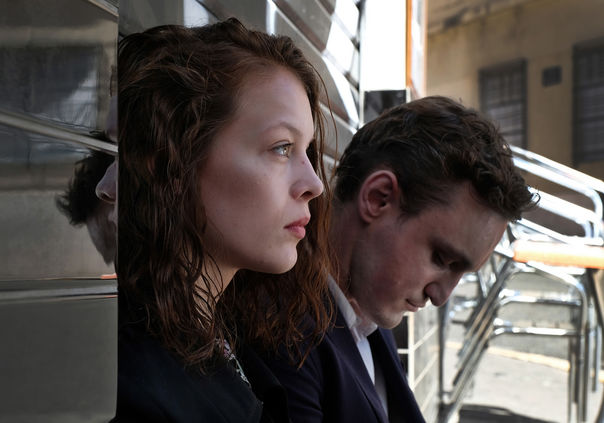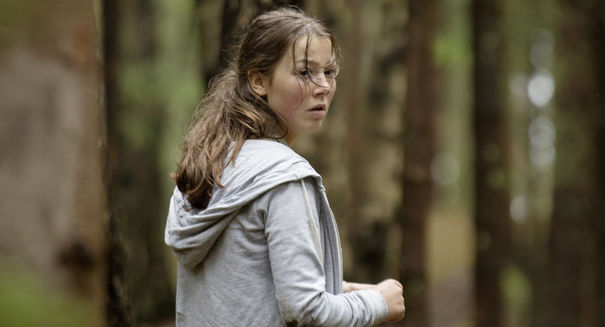CONCEALING TO REVEAL
By Carolina Iacucci

® Schramm Film / Christian Schulz
When an eel gives birth, it immediately abandons her babies and dies in the ocean. This process is a recurring visual element in Laura Bispuri’s DAUGHTER OF MINE, set on a barren Sardinian island. Vittoria, the pre-teen protagonist, asks her father for an explanation about the miserable fate of these animals, and her intense fascination suggests a kinship with the baby eels, in the way they’ve been ejected from their mother’s womb and abandoned. This father-daughter moment deals with the unspoken: they are apparently talking about the reproductive life of those aquatic animals, but are actually sharing a subtextual code about their own family.
This small, seemingly negligible moment makes all the difference in the film, for it makes us understand how not telling can be more powerful than telling. DAUGHTER OF MINE, as well as UTØYA 22. JULI and TRANSIT, all Competition films at the 68th Berlinale, each contain a secret in their storyline. But these secrets – a family origin, the psyche of a mass murderer, even the true reality of a film’s setting and characters – get revealed not by addressing them directly, but solely by evoking palpable inconsistencies through images and feelings.
Redheaded, freckle-faced, and extremely pale, Vittoria looks like an otherworldly creature from a folk fairy tale. She has been raised by a selfless but hyper-protective foster mother. When her birth mother Angelica comes to the village from the city, Vittoria undergoes a sort of enchantment: their shared exotic appearance creates a visual commonality. Words are not needed to clarify their bond, because their resemblance says it all.
With her naturalistic gaze, the director accompanies a young girl in her voyage of self-discovery by effectively communicating the subtle feeling that the truth was already there, ready to blossom. The filmmaker never reveals the secret of Vittoria’s true parentage explicitly, suggesting it both phenotypically and chromatically instead. It is crucial the way cinematographer Vladan Radovic uses his technical skills and aesthetic sensitivity to provide the Sardinian setting with an almost corporeal texture, by stressing the dimensions of its mountains and the expressive power of its reddish palette. In this way, the island acts as a secret family member who not only silently witnesses the affective triangle between the foster mother, the birth mother, and the young “split” girl, but also communicates with them and reinforces their bond.

The film’s theme of embracing inclusivity by challenging established parental roles and family symmetry as the conceptual landing place of the drama is reflected in both the setting and the chromatic spectrum. As the female trio in the story, also the signifier and the signified, the visual surface and the ideological core are bonded: their glue is not the revealing word, but the cinematic image invested with both narrative meaning and conceptual purpose.
In a similar way, UTØYA 22. JULI by Norwegian director Erik Poppe renounces to show the “body” of its dramatic motive in order to make room for sensory perception. It fictionalises the murderous attack by the heavily armed right-wing extremist Anders Breivik, who shot dead 69 teens at a summer camp on the island of Utøya in July 2011. The murderer is treated in a phantasmal way, kept off screen, the source of his evil left inscrutable. He is a ghostly entity haunting the characters and leaving them totally helpless, exposed to the bare essence of naturalistic time and to their own nude frailty. The film is ultimately an immersive cinematic experience of the trauma of impotence.
The director displays prodigious technical skills by brutally recreating in one long continuous shot the anguish of one student, Kaja, as she is chased by the shooter without knowing what is happening or why. The choice of maintaining the perspective of the victims – by following Kaja’s fight for survival for most of the film – is informed by the will to avoid directing the film towards an essayistic study on the killer’s psychological disturbance and moral void.
Thus, what the spectator is led to experience is the compassionate sharing of anxiety and grief. Poppe actually does not refuse complexity or give up looking at cruelty with a straight gaze, but instead refuses to consider cruelty as a moral question which can be understood through intellectual analysis. The film asserts that the most important way people can relate to tragedy is not by debating its moral implications, but by accessing it emotionally.
In his feature TRANSIT, Christian Petzold aims at engaging the audience in a sensorial experience of displacement and disembodiment. A filmic update of the plot originally in Anna Seghers’ World War II novel to a present-day Marseille with no references to recognisable current events, Petzold wants the spectators to become confused and plunge into the secrets of a fractured and alienated society. Following Georg, a German refugee who falls in love with Marie, the wife of a dead writer whose identity he must assume in order to obtain the visa to expatriate, Petzold creates a simultaneously retrospective and futuristic, old-fashioned and dystopian tale of mistaken identities and shaken feelings of belonging.
Petzold’s characters flit suspended in the realm of in-between: does the story take place in the past, the present, or the future? Why does everybody want to migrate and exactly which kind of hunt are they escaping from? Are they lost souls wandering in the night of their own dissolute life, or are they projections of the storyteller’s delusional imagination? Is Nazism behind them, buried in their past, or is it expected to come and surprise them?
Petzold conceals the truth about his characters, the spaces where they move and the times in which they live to urge the viewer to rewrite reality. By stripping his characters of coordinates that place their identities, he reveals their allegorical, purely speculative nature. By de-historicising and hiding chronological details, he unveils a universal truth about the illusory nature of human connection to the world, and its vulnerability to both social and political dehumanization.
DAUGHTER OF MINE, UTØYA 22. JULI and TRANSIT all depict the process of feeling the truth rather than intellectualising it. They explore a technique of narrative “secretiveness” in order to enable their viewers to relate sensorially to the story and its grey areas. Both characters and spectators discover their secrets simultaneously, and beyond spoken words.

